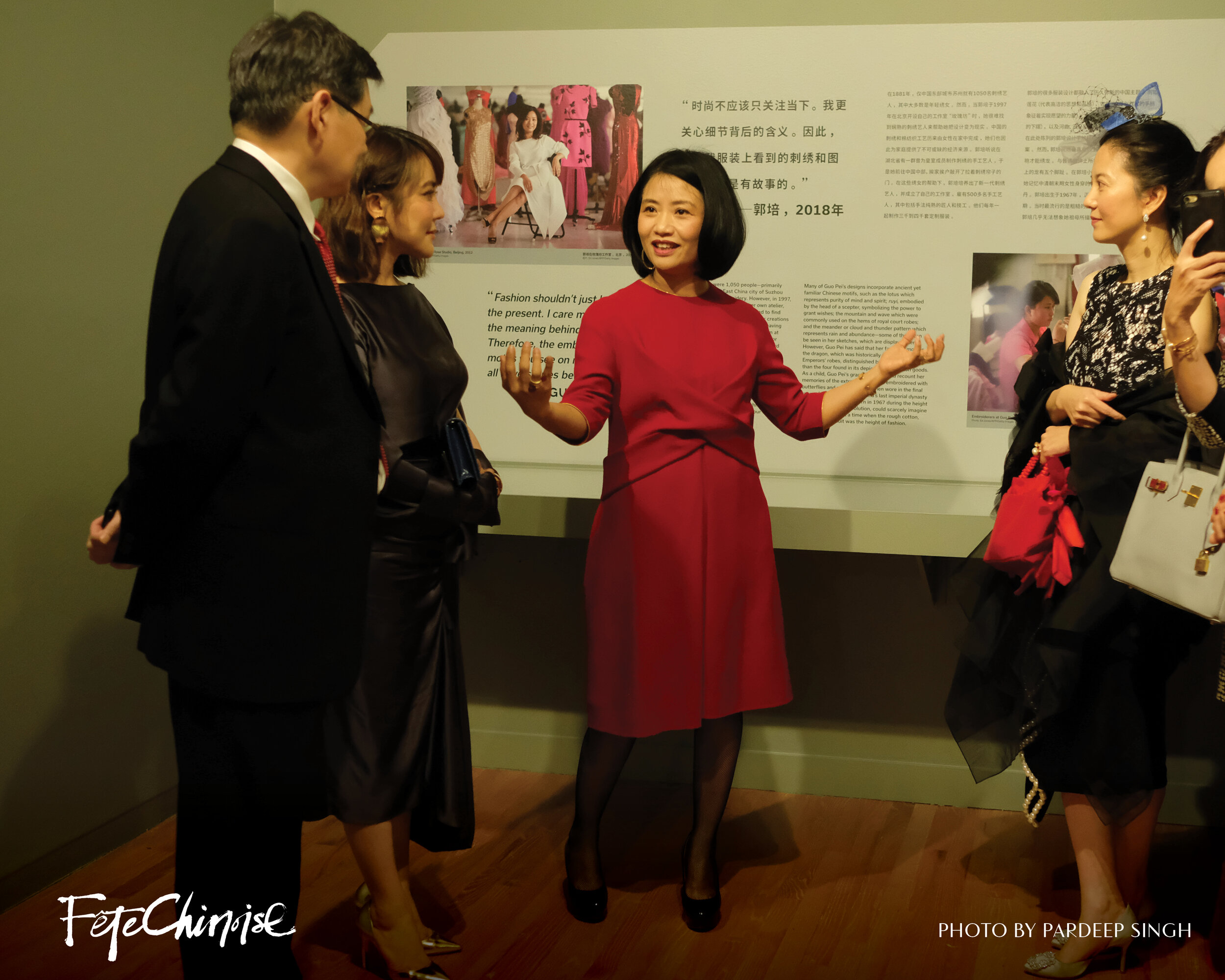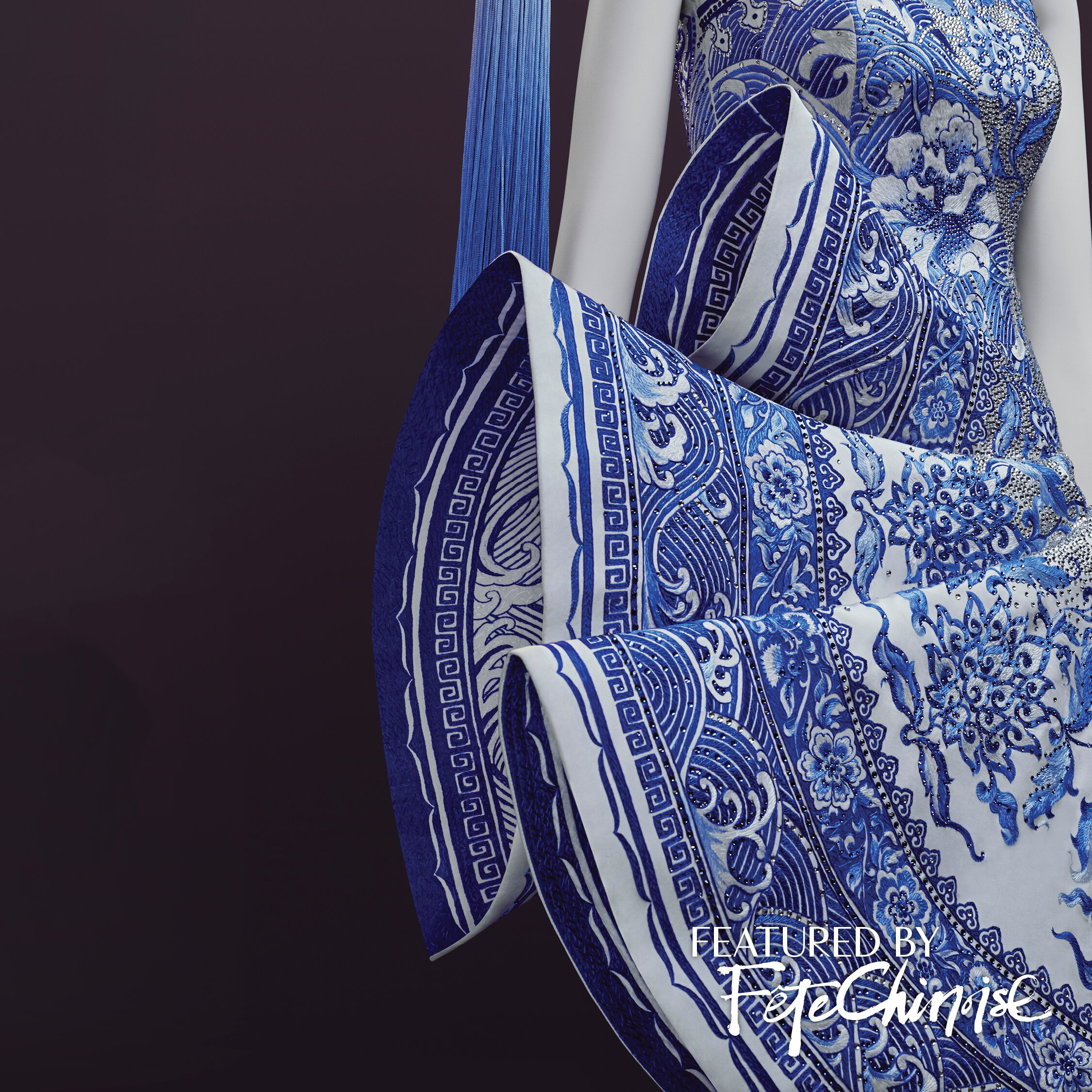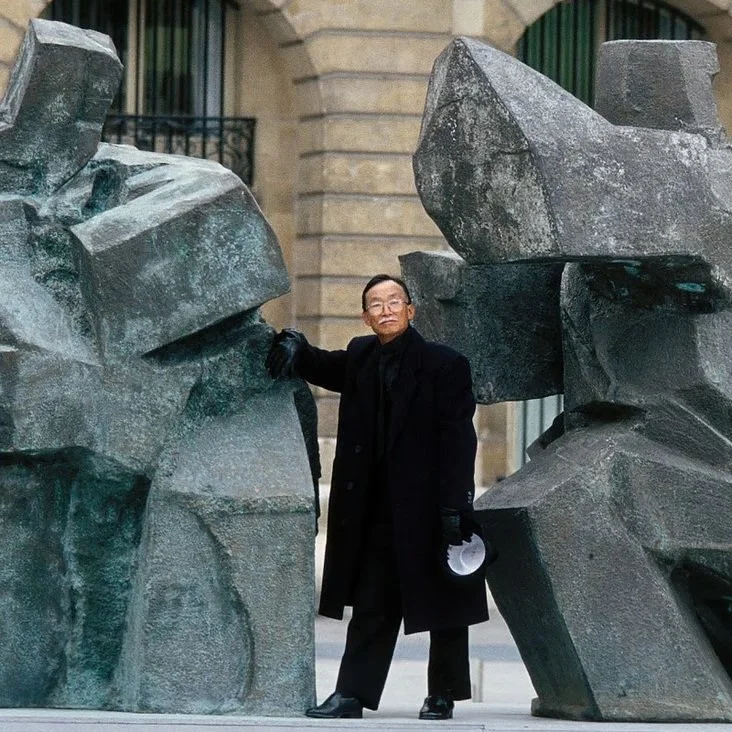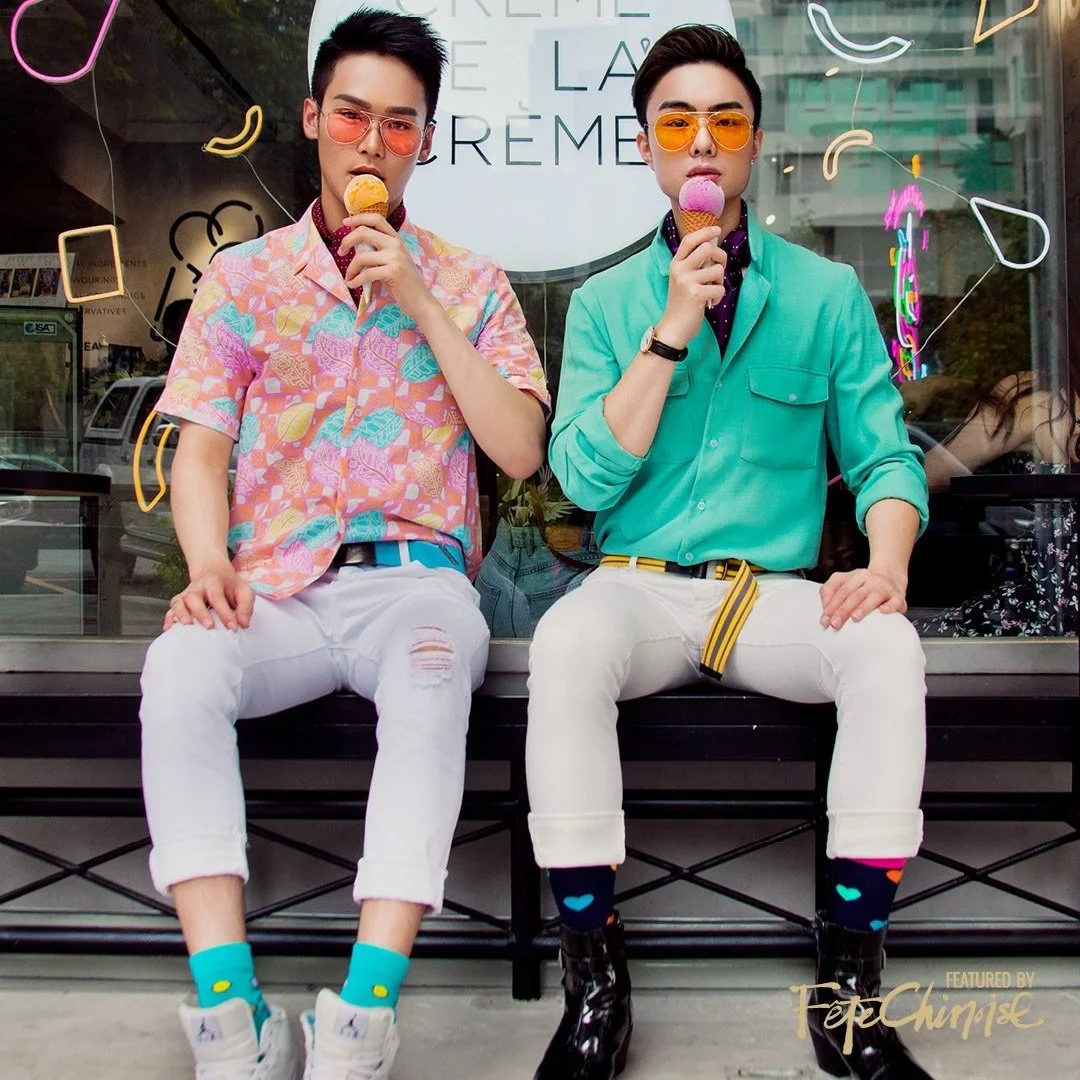The Empire's New clothes 中華帝國的新衣: How Beijing Designer Guopei is Spearheading a Fashion Revolution in Her Native China 郭培的中國時尚革命
Interviewed by Deborah Lau-Yu and Jennifer J. Lau
Written by Deirdre Kelly
Translated by Wilson Wong
With notes from the Vancouver Art Gallery Exhibition
(from October 12, 2018 to January 20, 2019)
Photography: SCAD, Butter Studios, Scott Little, and Pardir Singh
Guo Pei, One Thousand and Two Nights, 2010.
Silk cloak embroidered with metal thread and silk & 24-karat-gold-spun thread. adorned with silk bows and fox fur.
Photo: Courtesy of SCAD
Born in 1967, at the start of Mao Zedong’s Cultural Revolution, Guo Pei never knew fashion. In China, the word did not even exist. It was banished along with handicraft traditions and other artistic pursuits deemed unworthy to the great proletariat cause.
But while growing up in Beijing, Guo listened to her grandmother telling her stories about the gold-thread embroidery that once sparkled within China’s ancient palaces. It inspired her to find a way to restore that centuries-old tradition back to the culture as a source of national pride and self-expression.
“This is an invaluable asset,” says Guo, who is today China’s premiere haute couture designer with more than 30 years of experience designing special occasion clothing for her country’s best-dressed women. “China has a 5000-year old cultural history. Through traditional artisanal craftsmanship I can find the glory of the past.”
郭培於1967年出生,孩童時代適逢文化大革命,成長時從未接觸過時裝。事實上,當時的中共只接受官方藝術,非官方藝術都被視為反動的;在這個連傳統手工藝也被打壓的年代,作為西方產物的時裝藝術當然被抹殺。
但這環境並抺殺不了郭培對時裝的興趣。在北京長大的她,有一個出身大戶人家的外婆,小時常聽其外婆訴說漂亮衣服的故事,譬如宮庭裏的盤金繡如何璀璨美麗之類。趕上改革開放的年代,郭培成為了第一批中國服裝設計專業的畢業生。外婆的故事都成為了郭培的啟發,她將自己的藝術表達與傳統工藝結合,一方面令工藝得已傳承,另一方面令中國人對中華傳統工藝重捨自豪。
今天,郭培已經是中國首屈一指的高定設計師,為中國女性披上華衣三十載。就中華傳統工藝,她有這樣的看法:「這是一筆非常寶貴的財富,中國有五千年的文化歷史,我能從傳統藝術家的工藝中感受到過去的輝煌。」
Guo Pei, One Thousand and Two Nights, 2010
embroidered silk gown with hand-painted motifs and embellished with Swarovski crystals; porcelain headpiece ornamented with crystals and silk tassels.
Photo: Courtesy of SCAD
That glory shines through all of Guo Pei’s work, from the fur-trimmed canary yellow 25-kilo gown which pop star Rihanna — cementing Guo’s international reputation — wore in 2015 to the Metropolitan Museum of Art’s Costume Institute Gala in New York, to the form fitting-iridescent metallic sheaths with 3D embroidery which walked the Paris runway for the first time in 2017 after the French Chambre de Syndicale de la Haute Couture invited Guo to participate in what is generally known as the mother of all fashion events.
事實上,中華文化的輝煌的確顯現在郭培的作品上。2015年,流行巨星蕾哈娜出穿上郭培設計的黃袍出席紐約大都會藝術博物館慈善晚宴,令郭培成功站上世界舞台。2017年,高定的始祖,法國高級時裝協會邀請郭培參展,郭培將立體刺繡帶上了巴黎的時裝天橋。不論是2015年的黃袍還是2017的立體刺繡裙,郭培最出色的作品都運用了中華傳統的製衣元素。
Guo’s Paris debut forms the focus of Yellow is Forbidden, New Zealand director Pietra Brittkelly’s acclaimed 2018 documentary about how a previously obscure Chinese designer, using mainly ancient Chinese crafts and techniques, came to infiltrate and inspire a world dominated by such top Western fashion brands as Chanel, Dior, Gucci and Prada. “Couture is more than a piece of clothing,” Guo says in the film. “It’s an expression. It’s art.”
紐西蘭導演 Pietra Brittkelly 看準郭培打入國際市場,對國際時裝界造成的衝擊,將她的巴黎展拍成記錄片 —「明黃禁色」。片中記錄了郭培如何由不為人知的中國設計師,以中式刺繡和裁縫技術,在這個由歐洲各大名牌掌控的時裝界取得一席位。
The title references a directive issued by Guo’s grandmother in response to Guo’s request to wear a dress when she was a girl in a hue favoured by the emperors of imperial China. Guo listened, but happily did not obey. Yellow, symbolizing luck in Chinese culture, is today her signature colour, and it lends a rich cast to the Dajin (Magnificent Gold) dress made 10 years ago and over an epic course of 50,000 hours. “This is equivalent to nearly six years of a person’s life,” Guo says, still marvelling at the feat. “How many ‘six years’ such as this can anyone have?” The dress is today displayed as part of museum exhibitions around the world. Guo considers it her masterpiece.
“It has surpassed the limitations of time and space,” the 48-year-old married mother observes, “enabling Western society to understand the innovation within Chinese fashion. It’s hard to choose one of my pieces,” she adds, “but if I have to say which one is most important, it is Magnificent Gold.”
Guo Pei, One Thousand and Two Nights, 2010 (details)
embroidered silk gown with hand-painted motifs and embellished with Swarovski crystals; porcelain headpiece ornamented with crystals and silk tassels.
Photo: Courtesy of SCAD
郭培在電影中道:「高級定製時裝,不單是一件服飾。它是一種表達,一種藝術。」其實這種思想早就在她小時候萌芽。郭培小時候曾經想穿黃裙,但被奶奶告知這是皇帝的忌諱,「士庶不得穿赤黃」,穿黃衣是對皇帝的冒犯。郭培未有聽從奶奶的勸告,現在,明黃已成為她的作品的代表色。這被「紫禁的黃袍」,更成就了她人生中藝術的高峰之作 —「大金」。「大金」是郭培2006年的作品,秏時之巨達5萬小時,現在作為展品在世界各地的博物館中展出。對於「大金」,郭培感嘆道:「這相當於一個人近6年的生命,我們能有多少個這樣的6年呢?」
Yellow is Forbidden opened at New York’s Tribeca film festival in March and has since been touring the international film circuit, garnering strong reviews for having captured not only Guo’s extraordinary pioneering spirit but also China’s radically shifting social and political circumstances allowing it to soar. Even Guo acknowledges that, her determination and talent aside, she owes her success to being in the right place at the right time. China is rising like the sun in the east and Guo finds herself bathed in the glow.
「明黃禁色」今年三月率先在紐約翠貝卡電影節首映,其後持續在世界各地的電影圈安排播放。電影的反應良好,它除了成功地捕捉郭培的創新思維,更重要的是它現實地呈現了中國社會進步、變遷,對中國服裝設計師的影響。郭培自己也不得不承認,天時地利人和也很重要,她的成功不能只歸功於她的毅力和才華,還得感謝中國的復甦、掘起。「這兩年,最大的感觸是國人的民族自信越來越強,有不少有才華有理想的中國設計師走入人們的視野。這個和社會的經濟環境,文化復甦都有著直接的關系。」
“Over the past two years, I have been touched by the increasing confidence of the Chinese people in their nation. Many talented and creative Chinese designers have garnered attention. There is a direct relationship between the economy and cultural recovery,” says Guo. “China’s fashion industry is just getting started. No design can be separated from culture, art and craft. Chinese traditional culture will be the foundation on top of which our designers will flourish.”
That Guo is a trailblazer is confirmed by Vogue China editor-in-chief Angelica Cheung. “Guo Pei is in a category all of her own,” Cheung told the Times of London. “She worked on her business for many years to build it up. Now there are other people who do similar, but for a long time there weren’t.”
「中國的時裝行業才剛剛起步,我們有著五千年的歷史文化,這是一筆非常珍貴的財富,任何設計都脫離不了文化、藝術和工藝,中國的傳統文化也將是設計師們生存的土壤。」
郭培作為中國時裝界的開拓者的地位,早已被「Vogue 中國」主編,張宇,所認可。張宇曾在泰晤士報的訪問中如此評論郭培:「郭培作為設計師是特別的,是屬於特殊的種類;她成立自己的公作室,為自己的公司打拼多年。現在當然有不少人想復製她的營商模式,但在她之前這模式是不存在的。」
They weren’t doing so because embroidery had been outlawed during the Cultural Revolution, and as Guo has observed, anyone caught practicing a skill linked to the Emperors at that time would have been punished if not killed, “so no one was learning and no one was teaching — this kind of skill was lost." But there were survivors of the purges, embroiderers who had worked for the Royal Family who had gone into hiding in the lake district of Hubei province. Guo went into the Chinese countryside to find them, personally knocking on the doors of houses with embroidered curtains in the windows. She ended up recruiting as many people who were willing to return with her back to Beijing.
郭培的公作室不同之處,是她意識到傳統工藝非法化對傳統工藝最大的衝擊,而是其做成的人才流失。即使改革開放後工藝不再受打壓,她也想:「隨著工業化的到來,這些工藝也越來越難以傳承下去,這不僅是時尚界的損失,而是全人類的損失。」於是,郭培走訪中國各地尋找躲藏起來的手工匠人,更在湖北找到了清朝御用刺繡師的繼承者。她把這些願意追隨她的匠人帶到北京,成立了工作室 — 玫瑰坊。
“When I do any design, I work with other artisans to study the craft each step of the way,” Guo says. “This passing of tradition is very meaningful and it is my hope that the next generation of designers can continue to study the art. It will help them understand craftsmanship techniques and find a sense of pure beauty.” But influences are not restricted to China. “I have always liked the work of Frida Kahlo,” she adds. “We were not born in the same era, but her art work inspires me. I hope that the beauty in my work touches others as well.”
玫瑰坊的服裝製作非常重視匠人的工藝,郭培解釋道:「我做設計時,是從跟工人一起研究工藝,一步步走到今天的,這個傳承的過程是非常有意思的,也希望能為下一代設計師留下值得考究的工藝。幫助他們在職業生涯中,去了解服裝手工藝的技術,感受最純粹的美。現在很多的年輕設計師都有豐富的學歷背景,他們非常珍視自己的文化,也有傳播它們的願望。精湛的工藝,對他們未來的創作也會有更大的幫助。」當然,郭培的靈感不只來自中國本地,她也有受到西方文化的啟發:「我一直都很喜歡弗裏達·卡洛(Frida Kahlo)的作品。我們並不生在同一個時代,但她的作品觸動了我,帶我走進了她那個時代的奇妙世界。我也希望我的作品中所呈現的美,能夠感動別人,當他們試圖從我的作品中了解東方、了解高級定制的時候,能獲得驚喜,尋找到答案。這也許是最好的被記住的方式吧。」
“When I do any design, I work with other artisans to study the craft each step of the way...”
That beauty rises from a couture business that today is in high demand. Founded in 1997, her Rose Studio in Beijing employs over 500 Chinese artisans, 300 of whom are embroiderers and 200 of whom are designers. Together, they produce up to 5,000 pieces a year at prices ranging from $4,000 to $50,000 USD for garments made of real pearls and hand-appliqued coloured crystals. The clients for such exquisite creations include such leading Chinese actresses as Li BingBing and Zhang Ziyi and prominent social figures as Zhang Zetian, wife of the Chinese e-commerce entrepreneur Liu Qiangdong, who sat front row at Guo’s 2017 Paris haute couture show.
SPONSORED BY PIAGET.
現在時裝已在中國發展出需求。於1997年成立的玫瑰坊,現聘有500位手工匠人,其中300人是刺繡師,另有200人是設計師;每年手工生產大約5000件高級時裝,售價由4千美元至5萬美元不等;客戶包括著名影星李冰冰、章子怡,等等。「我現在的工作室,有近500位手工匠人,他們都是我一點點培養起來的,希望我的作品可以成為這些工藝的媒介,將屬於這個時代的美好與精致流傳下去。」
To allow a greater number of women to share in her luxurious creations, Guo launched a demi line of bridal gowns aimed at the Chinese market in 2015. As reported in fashion trade publication WWD, traditional Chinese gowns are currently popular with young Chinese consumers, and again largely because of Guo Pei. Her Chinese Wedding Dress Collection “incorporates a lot of traditional craftsmanship,” and features patterns “with auspicious and beautiful meanings true to the spirit of the costume,” Guo says, adding that she combines tradition with new practices to make them relevant to today.
帶著這種想法的郭培,更感慨高定始終不是一般人能買得到之服裝。於是,她在2015年開發了新的服裝產品,婚紗系列 —「中國嫁衣」,讓更多的中國人有機會接觸、穿上她為國人製作的高級時裝。跟據時裝刊物 WWD 的數據,中式婚紗在中國越來越流行,而這個轉變不得不歸於郭培。這個系列的精髓,必須由郭培自己解釋:「我一直在做的『中國嫁衣』系列,裏面就融入了非常多的傳統工藝,無論是帶有吉祥美好寓意的圖案,還是服飾中的精氣神,都是我從傳統服飾中汲取的靈感,但我以一種新的方式進行組合和創造,就拿我品牌所特有的金繡來說,它源自於宮廷服飾上盤金繡,是一種近乎失傳的工藝,當時我的團隊為了研發這項技術,開發出更豐富的表達手法,繡工們一天要紉300次線才能縫制出一個繡片,因為金線是非常脆弱的,要反覆的去研究它縫制的技巧和力度。從我創立玫瑰坊開始,就一直在做這種對傳統工藝的嘗試和創新。」
“The embroiderers have to thread 300 times a day to produce one embroidered piece,” Guo explains, “and because the gold thread is very delicate, we have had to investigate the right technique and required strength, over and over again. Since I founded the Rose Studio, I have been doing this kind of experimentation and innovation of traditional crafts.”
For such experimentation to continue, Guo personally trains the next generation of Chinese artisans to carry the legacy of handicraft traditions into the future. She admits that it is often hard to do. Handcrafted clothing takes time. And we live in a see-now-buy-now fashion world. But if traditional craftsmanship dies, so too does the culture. Guo for one is determined not to let that happen. The Chinese might be late in talking about fashion. But if she has her way, they might just have the last word.
“Chinese fashion represents a distinct voice,” Guo says. “The way the world understands China might be from a distance. But once more Chinese designers feel a sense of belonging to their roots and use that feeling to create something magnificent, they will open the door for the world to get to know Chinese culture.”
為了回覆更多失傳的工藝,並將其傳承傳下去,玫瑰坊不得不做更多的實驗和嘗試。為此,郭培親手培養了一代新中國的工匠藝人,並將將傳統工藝翻新、帶到未來的理念託付於他們。傳承的工作,連郭培也感到艱難。人手製作服裝非常費時,在這個時裝速食化的年代實在難以生存。但若果工藝失傳了,文化也隨之而逝,這是郭培最不願意看見的。中國在時裝藝術的路上起步雖然較慢,但若郭培的理念和手法得而延續,必定會令中國時裝成為國際時裝界上的重要派別。「中國時裝代表了一種不同的聲音,世界上很多人對中國的認識,可能在停留在很久遠的地方,而當更多的設計師對自己的根有了歸屬感,創作出很棒的設計時,那將向世界開啟一扇了解中國的大門。」
“... This passing of tradition is very meaningful and it is my hope that the next generation of designers can continue to study the art. It will help them understand craftsmanship techniques and find a sense of pure beauty.”
About the writer, Deirdre Kelly
Deirdre Kelly is an award-winning investigative reporter, dance critic, arts, fashion, lifestyle and news reporter and columnist known for her work at Canada’s The Globe and Mail newspaper. In 2017, she became Editor of The York University Magazine in Toronto.
SPONSORED BY PIAGET.




























